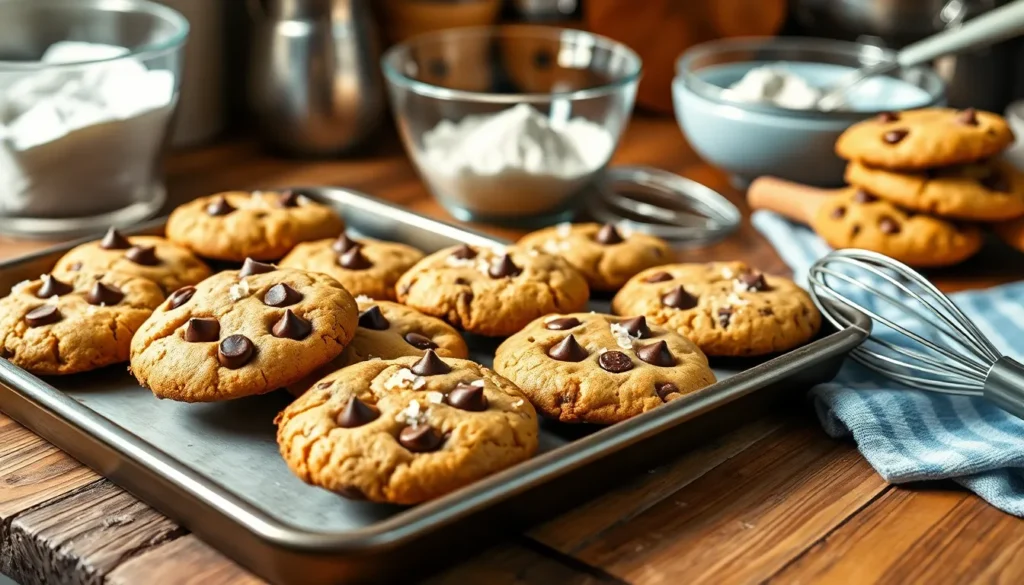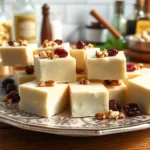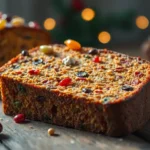We’ve perfected the ultimate vegan chocolate chip cookies that’ll make you forget they’re dairy-free! These soft and chewy treats deliver all the classic comfort you crave without any animal products. Whether you’re embracing a plant-based lifestyle or simply want to surprise friends and family with an inclusive dessert everyone can enjoy.
Our recipe transforms simple pantry staples into bakery-quality cookies that rival any traditional version. We’ve tested countless combinations to achieve that perfect balance of crispy edges and tender centers loaded with melty chocolate chips. The secret lies in our carefully selected plant-based ingredients that create rich flavor and ideal texture.
Ingredients
We’ve carefully selected each ingredient to deliver the perfect balance of flavor and texture in these vegan chocolate chip cookies. Our list focuses on pantry staples that work together to create cookies with crispy edges and soft centers.
Dry Ingredients
- 2¼ cups all-purpose flour
- 1 teaspoon baking soda
- 1 teaspoon fine sea salt
- ¾ cup granulated sugar
- ¾ cup packed light brown sugar
Wet Ingredients
- ¾ cup vegan butter, softened at room temperature
- ¼ cup unsweetened applesauce
- 2 teaspoons vanilla extract
- 3 tablespoons non-dairy milk (oat, almond, or soy)
Mix-ins
- 1½ cups vegan chocolate chips
- ½ cup chopped walnuts or pecans (optional)
- 1 teaspoon flaky sea salt for sprinkling (optional)
Equipment Needed
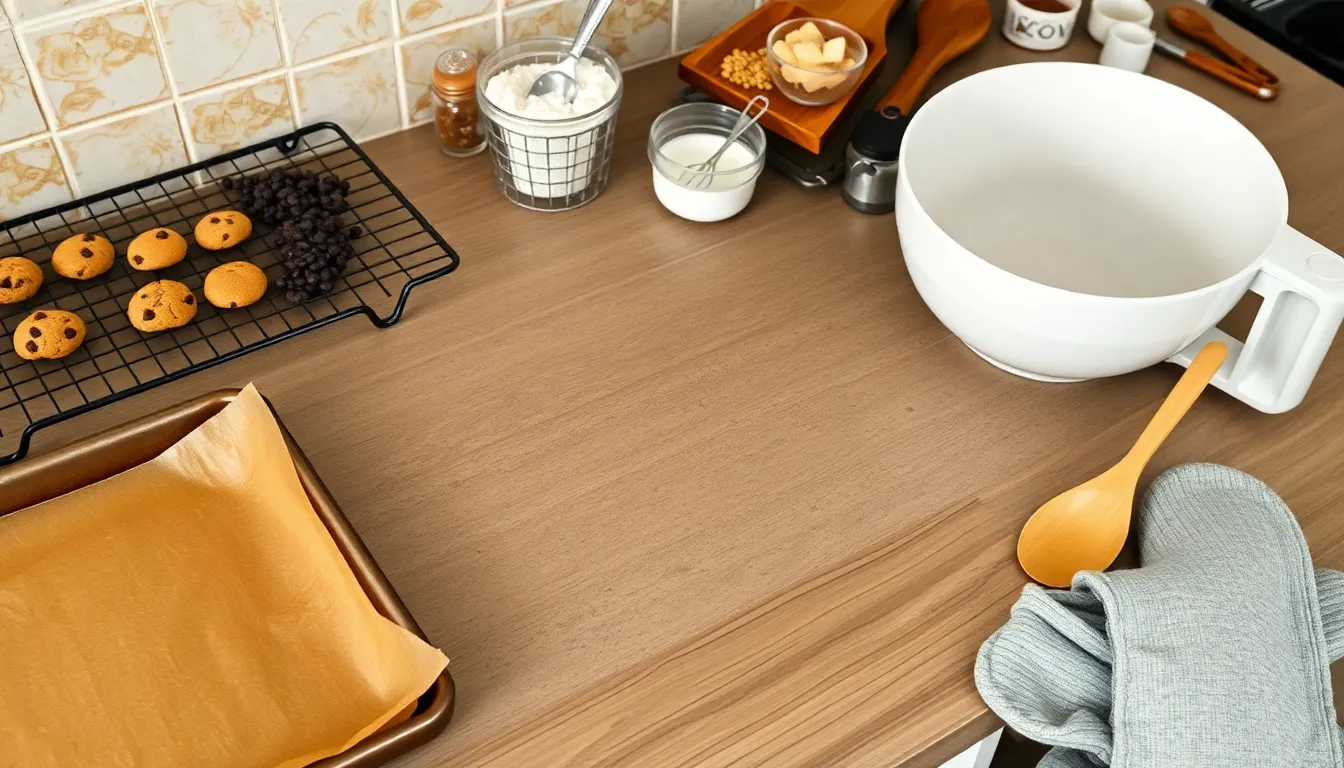
Creating perfect vegan chocolate chip cookies requires the right tools to ensure optimal results. We recommend gathering these essential pieces of equipment before starting our baking process.
Baking sheet serves as the foundation for our cookies and should be lined with parchment paper for easy removal and cleanup. Large rimmed baking sheets work best as they provide ample space for cookies to spread without overcrowding.
Cooling rack becomes essential for achieving the proper texture once our cookies emerge from the oven. This tool allows air to circulate around the cookies and prevents soggy bottoms that can occur when cookies cool directly on baking sheets.
Mixing bowl and spoon or stand mixer handles the crucial task of combining our ingredients into smooth cookie dough. We can use either a large mixing bowl with a wooden spoon for hand mixing or a stand mixer fitted with a paddle attachment for effortless blending.
Whisk or silicone spatula proves invaluable for blending ingredients smoothly and scraping down bowl sides during mixing. These tools ensure no pockets of dry ingredients remain in our finished dough.
Measuring cups and spoons guarantee accurate ingredient proportions that directly impact our cookies’ final texture and taste. We recommend using both liquid and dry measuring cups for the most precise results.
Hand mixer or stand mixer offers an optional but efficient approach to creaming our vegan butter and sugars together. This equipment creates the light and fluffy base that contributes to our cookies’ perfect chewy texture.
Oven mitts provide essential safety protection when handling hot baking sheets throughout the baking process. Quality heat resistant gloves prevent burns and allow confident maneuvering of our freshly baked treats.
Instructions
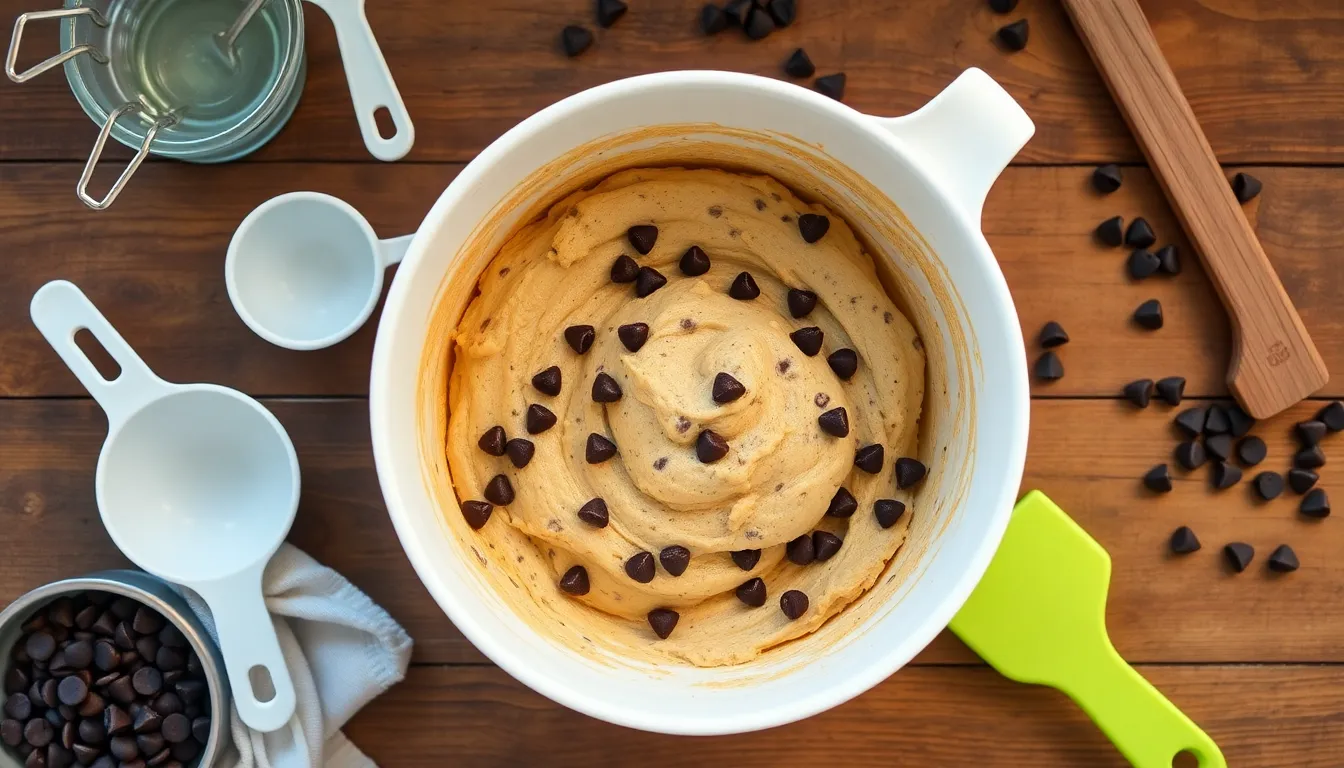
Now that we have our ingredients and equipment ready, let’s walk through each step to create perfectly soft and chewy vegan chocolate chip cookies. Follow these detailed instructions to achieve the ideal texture and flavor.
Prep the Dough
We start by combining our softened vegan butter with both granulated sugar and light brown sugar in a large mixing bowl. Beat the mixture until it becomes creamy and well incorporated, which typically takes 2-3 minutes with a hand mixer or stand mixer. Add the unsweetened applesauce, vanilla extract, and non-dairy milk to the butter mixture, mixing until everything is well combined.
In a separate bowl, we whisk together the all-purpose flour, baking soda, and fine sea salt. Gradually add these dry ingredients to the wet mixture, stirring just until combined to avoid overmixing. The dough should look uniform but still be slightly tacky to the touch. Fold in the vegan chocolate chips and any optional nuts using a silicone spatula, ensuring even distribution throughout the dough.
Chill the Dough
While chilling isn’t absolutely necessary, we recommend refrigerating the dough for at least 30 minutes to allow the flavors to meld together. This chilling step prevents excessive spreading during baking and results in thicker, chewier cookies with better texture. Cover the bowl with plastic wrap or transfer the dough to an airtight container before placing it in the refrigerator.
For best results, we can chill the dough for up to overnight, which intensifies the flavors even more. The longer chilling time creates cookies with more complex taste and improved texture.
Shape and Bake
Preheat the oven to 350°F (180°C) and line our baking sheets with parchment paper. Using a cookie scoop or spoon, we portion the chilled dough into balls and place them at least 2 inches apart on the prepared baking sheets to allow for spreading. For extra chocolate appeal, we can press additional chocolate chips onto the top of each dough ball before baking.
Bake the cookies for 9-15 minutes, depending on our desired texture preference. For softer cookies, we bake for the shorter time until the edges are just set. For chewier cookies, we extend the baking time until the edges become lightly golden while the centers still look slightly underbaked.
Cool and Store
Remove the cookies from the oven and let them cool on the baking sheet for 5-10 minutes before transferring to a wire rack. This cooling time prevents the cookies from breaking apart while they’re still warm and allows them to finish setting properly.
Once completely cooled, we store the cookies in an airtight container following these guidelines:
| Storage Method | Duration |
|---|---|
| Room temperature | Up to 1 week |
| Refrigerator | Up to 2 weeks |
| Freezer | Up to 2 months |
Always use room temperature ingredients unless specified otherwise for the best mixing results and optimal cookie texture.
Tips for Perfect Vegan Chocolate Chip Cookies
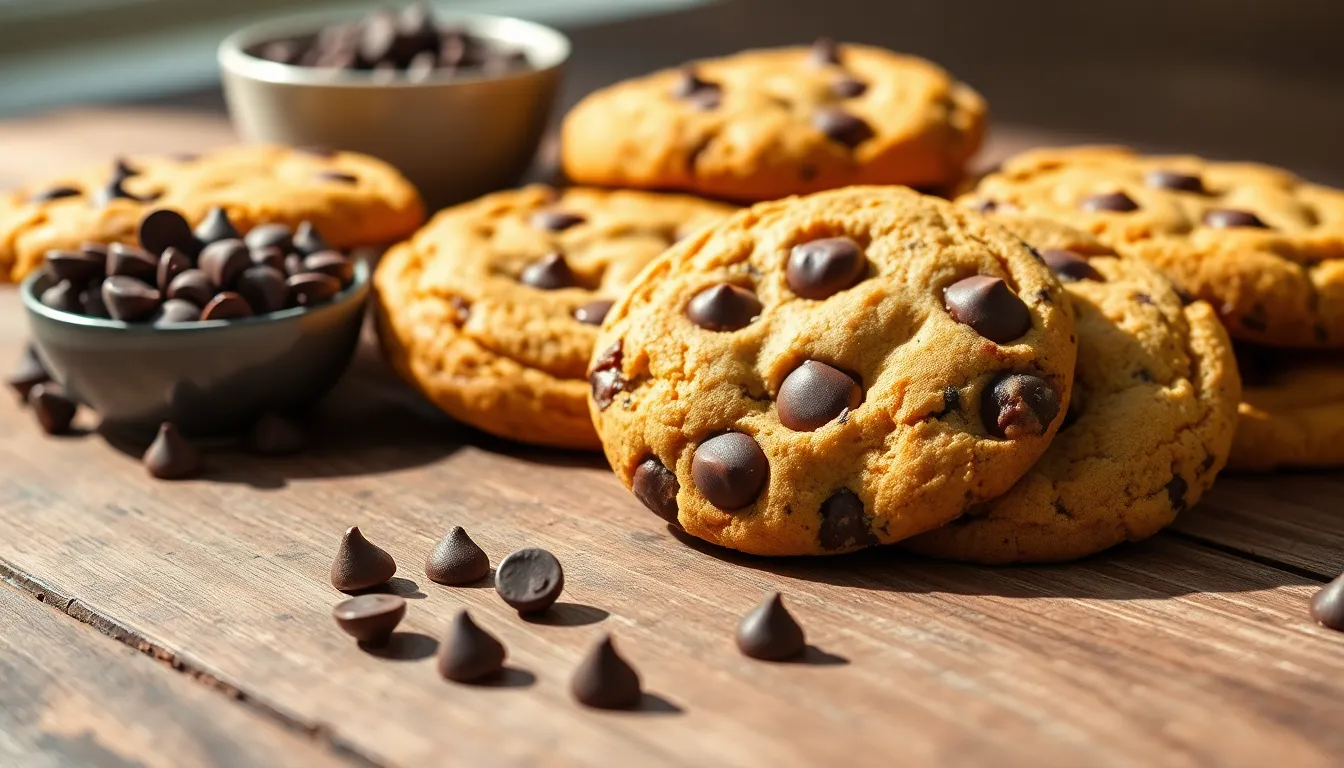
Creating exceptional vegan chocolate chip cookies requires strategic ingredient choices and technique refinements. We’ve compiled essential tips to help you achieve bakery-quality results every time.
Choosing the Right Vegan Butter
Vegan butter serves as our preferred fat choice over coconut oil for optimal cookie texture. Coconut oil’s 100% fat content often produces crumbly cookies while vegan butter contains water that contributes essential moisture to the dough.
Miyoko’s and Plant Crock rank among our top recommendations for vegan butter brands. These options deliver excellent taste profiles and superior browning properties that enhance both flavor and appearance.
Room temperature vegan butter creates the ideal consistency for creaming with sugars. We recommend removing it from the refrigerator 30 minutes before baking to ensure proper softening.
Selecting Vegan Chocolate Chips
Chopped chocolate elevates cookie texture and flavor beyond traditional chocolate chips. We suggest using a sharp knife to create irregular pieces that melt beautifully and create appealing chocolate pools throughout each cookie.
Dairy-free chocolate options maintain the vegan integrity of your cookies while delivering rich chocolate flavor. Always verify ingredient labels to ensure no milk derivatives are included in your chocolate selection.
Premium dark chocolate with 60-70% cocoa content provides the perfect balance of sweetness and chocolate intensity. This percentage range complements the cookie dough without overpowering other flavors.
Achieving the Perfect Texture
Dairy-free yogurt functions as an excellent egg replacement that promotes chewy cookie texture. We recommend using plain unsweetened varieties to avoid adding unwanted flavors or excess sugar to the dough.
Mixing technique plays a crucial role in cookie texture development. We combine ingredients just until they unite then gently fold in chocolate chips to prevent overdevelopment of gluten proteins that create tough cookies.
| Texture Element | Technique | Result |
|---|---|---|
| Chewiness | Chill dough 30 minutes | Better shape retention |
| Softness | Bake until edges are lightly done | Continued cooking while cooling |
| Flavor depth | Use oat or spelt flour | Enhanced nutty notes |
Chilling the dough for at least 30 minutes helps cookies maintain their shape during baking. This technique prevents excessive spreading and creates more defined edges with tender centers.
Baking time determines final cookie texture. We remove cookies when edges appear lightly golden as they continue cooking on the hot baking sheet during the cooling process.
Alternative flours like oat or spelt create unique texture variations. These options add subtle nutty flavors while maintaining the soft chewy consistency we desire in perfect vegan chocolate chip cookies.
Variations and Substitutions
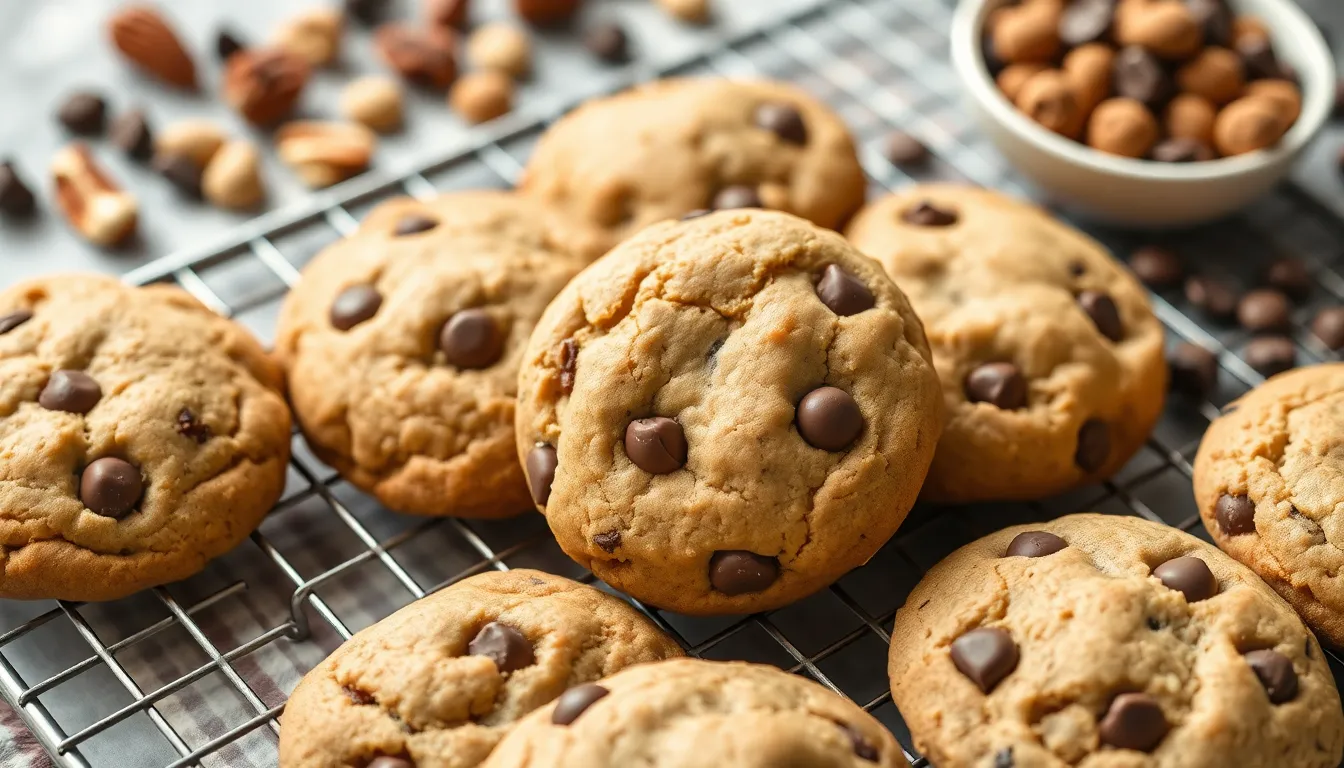
These versatile vegan chocolate chip cookies can be easily customized to meet different dietary needs and flavor preferences. We’ve tested many substitutions to ensure each variation maintains the perfect texture and taste you’re looking for.
Gluten-Free Option
Creating gluten-free vegan chocolate chip cookies requires just one simple swap. We replace the all-purpose flour with a gluten-free flour blend that contains xanthan gum for proper structure. If your chosen blend doesn’t include xanthan gum, add 1/4 teaspoon per cup of gluten-free flour to achieve the same binding effect. The remaining ingredients stay exactly the same, making this modification incredibly straightforward. No other adjustments are necessary unless your exact flour blend requires additional binding agents.
Sugar Alternatives
Brown sugar serves as our base sweetener because it provides caramel notes and essential moisture retention. Several alternatives work beautifully when you want to experiment with different flavors or dietary requirements:
| Sugar Type | Replacement Ratio | Texture Impact | Flavor Notes |
|---|---|---|---|
| Coconut sugar | 1:1 | Similar moistness | Mild caramel flavor |
| Maple syrup/Agave | 3/4 cup per 1 cup | Reduce other liquids | Natural sweetness |
| Monk fruit blend | 1:1 | Less chewy | Neutral taste |
| Erythritol | 1:1 | Less chewy | Clean sweetness |
Liquid sweeteners like maple syrup or agave nectar require reducing the non-dairy milk in the recipe to maintain proper dough consistency. Monk fruit or erythritol blends create a less chewy texture compared to brown sugar but work well for reduced sugar content.
Add-in Ideas
Beyond traditional chocolate chips, we love incorporating various mix-ins to create unique flavor profiles and textures. Nuts like walnuts, pecans, or almonds add satisfying crunch and richness. Dried fruits such as raisins, cranberries, or chopped dates contribute natural sweetness and chewy texture contrast.
Rolled oats make the cookies more substantial and create an appealing chewier bite. Seeds like chia, flax, or sunflower boost the nutritional value while adding subtle nutty flavors. Different chocolate varieties including white, dark, or flavored vegan chocolates offer endless possibilities for customization. We recommend using about 1/2 to 3/4 cup of any combination of these add-ins for the best balance without overwhelming the cookie structure.
Storage and Make-Ahead Instructions
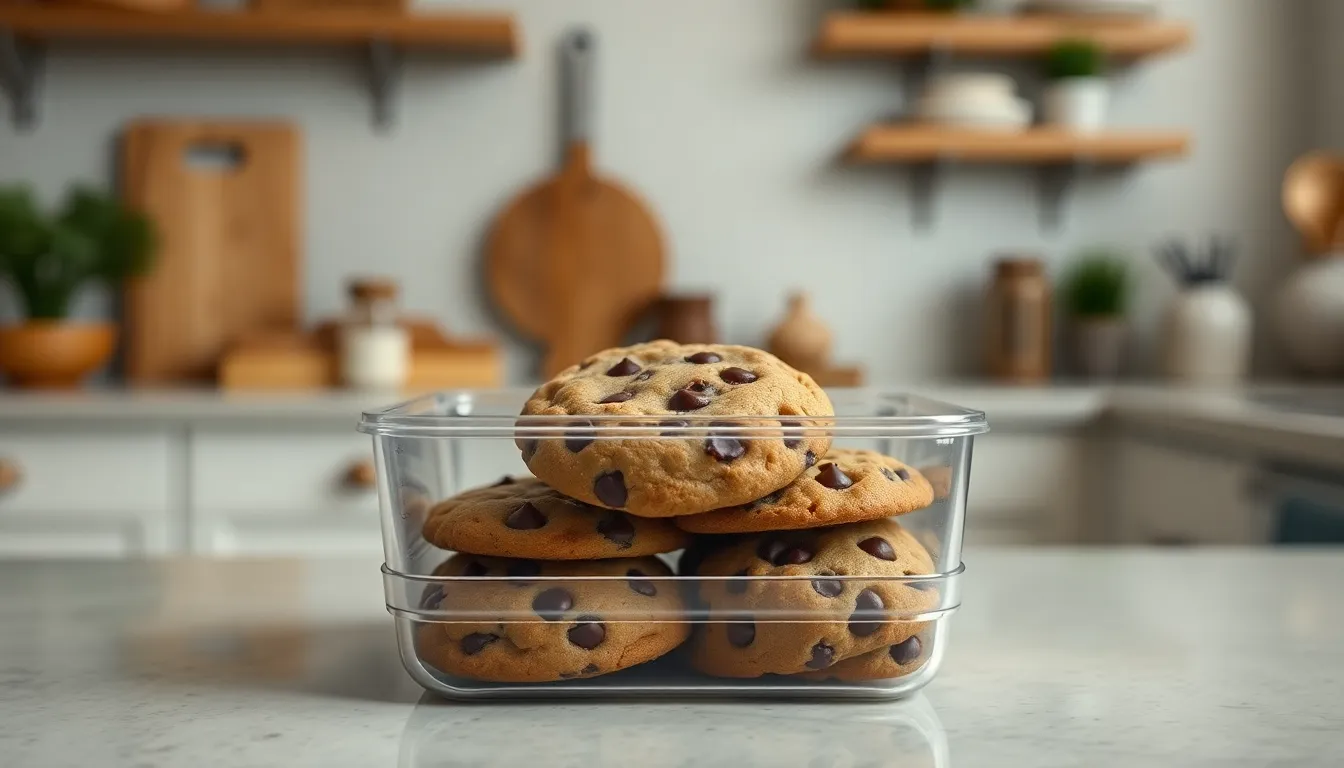
We’ve perfected the art of keeping these vegan chocolate chip cookies fresh and delicious for days. Our storage methods ensure you can enjoy that perfect chewy texture whenever a craving strikes.
Storing Baked Cookies
Room Temperature Storage: Store your baked vegan chocolate chip cookies in an airtight container at room temperature. Multiple sources confirm different shelf life periods:
| Storage Method | Duration | Source |
|---|---|---|
| Room Temperature | Up to 3 days | Earthly Provisions |
| Room Temperature | Up to 5 days | Love and Lemons |
| Room Temperature | Up to 1 week | Sweet Simple Vegan |
| Room Temperature | Up to 1 week | Censored Baker |
Extended Storage Options: Refrigerate your cookies for up to one week when you need longer storage. Place them in an airtight container to maintain their soft texture and prevent them from absorbing other flavors.
Freezing for Long Term: Freeze baked cookies for up to one month in freezer-safe containers or bags. Allow frozen cookies to thaw at room temperature for best results. We recommend using the microwave for quick defrosting when you need immediate cookie satisfaction.
Storage Best Practices: Ensure cookies cool completely before storing to prevent moisture buildup inside containers. Keep stored cookies in cool dry places away from direct sunlight and heat sources to maintain optimal texture and flavor.
Freezing Cookie Dough
Portioning the Dough: Use a 2-tablespoon cookie scoop to create uniform portions on a parchment-lined baking sheet. This method ensures consistent cookie sizes and even baking results.
Initial Freezing Process: Freeze the scooped dough portions for 2 hours or until they become completely firm. This step prevents the dough balls from sticking together during long-term storage.
Long Term Storage: Transfer frozen dough balls to airtight containers or freezer bags for up to 3 months. Label containers with the date to track freshness and ensure optimal quality.
Baking from Frozen: Bake frozen dough balls directly without thawing first. This convenience allows you to enjoy fresh warm cookies whenever you want them without advance planning.
Troubleshooting Common Issues
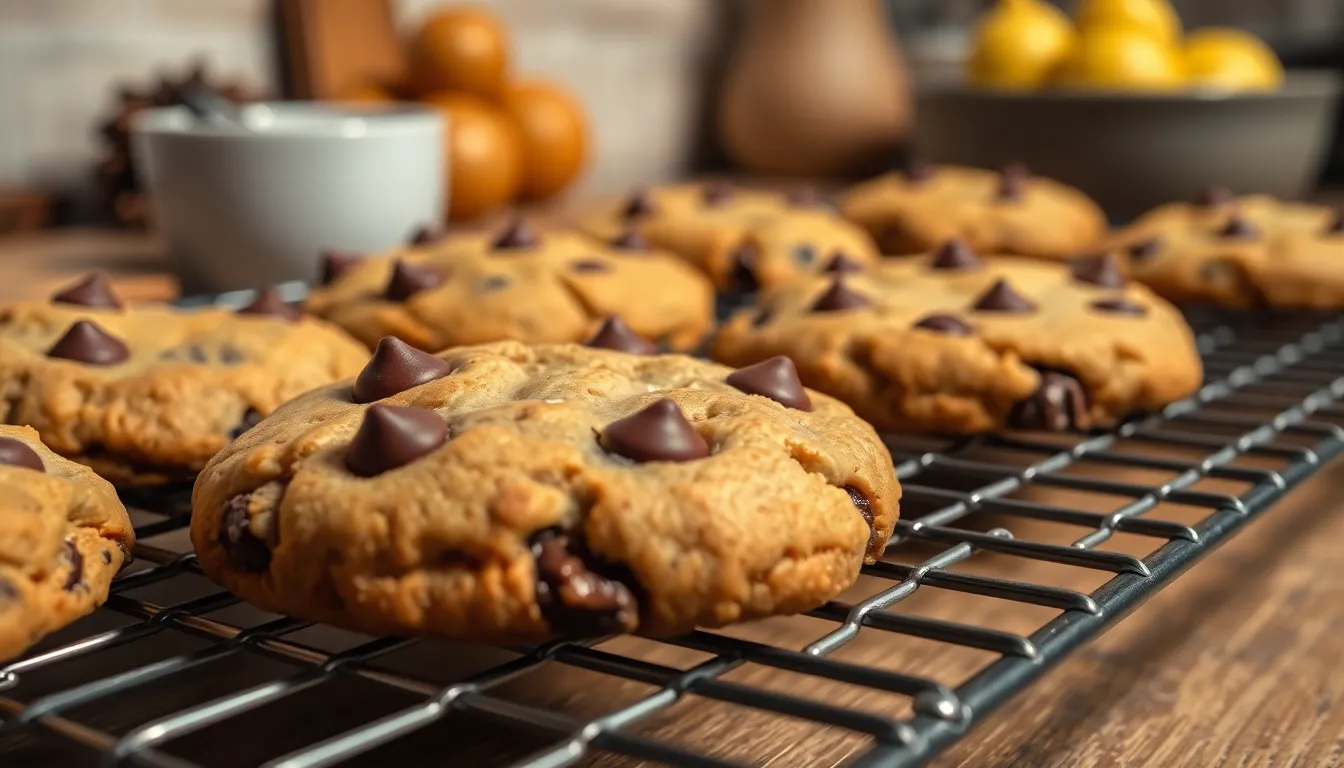
Even experienced bakers encounter challenges when making vegan chocolate chip cookies. We’ve compiled answers to the most common problems to help you achieve perfect results every time.
Cookies Are Too Greasy
Greasy cookies typically result from vegan butter that’s too warm during mixing. We recommend ensuring your vegan butter reaches room temperature without becoming overly soft. If the butter feels too warm refrigerate it for a few minutes until it firms up slightly. The ideal consistency should allow you to press a finger into the butter without it melting immediately.
Cookies Don’t Spread Properly
When cookies fail to spread during baking we usually find insufficient fat content or excessive flour as the culprit. Adjust your flour-to-fat ratio by reducing flour by 1-2 tablespoons or increasing vegan butter slightly. We suggest measuring flour by weight rather than volume for more consistent results.
Cookies Turn Out Too Thin or Flat
Flat cookies often indicate expired leavening agents or inadequate structure in the dough. Check expiration dates on your baking soda and baking powder since expired leaveners lose their effectiveness. Add an extra 2-3 tablespoons of flour if your cookies consistently spread too much during baking.
| Problem | Cause | Solution |
|---|---|---|
| Too Greasy | Butter too warm | Refrigerate butter 5-10 minutes |
| Won’t Spread | Low fat or too much flour | Reduce flour or add fat |
| Too Flat | Expired leaveners | Check dates, add flour |
| Too Crumbly | Insufficient moisture | Add 1-2 tsp non-dairy milk |
| Too Hard | Overbaking | Reduce baking time by 1-2 minutes |
Cookies Are Too Crumbly
Crumbly texture usually stems from insufficient moisture in the dough or overmixing. Add one to two teaspoons of non-dairy milk to bind the ingredients better. We advise mixing just until ingredients combine to prevent breaking down the dough’s structure.
Cookies Are Too Hard or Overcooked
Overbaking creates hard cookies that lose their desired chewy texture. We recommend checking cookies 1-2 minutes before the suggested baking time since they continue cooking on the hot pan after removal. Look for edges that appear set while centers remain slightly soft.
Cookies Lack Chewiness
Achieving the perfect chewy texture requires precise timing and moisture balance. Reduce baking time by one to two minutes and ensure your dough contains adequate moisture from ingredients like applesauce or non-dairy milk. We find that slightly underbaking produces the ideal chewy consistency.
General Prevention Tips
Chilling your dough for at least 30 minutes helps cookies maintain their shape and prevents excessive spreading. We always verify our oven temperature with an independent thermometer since incorrect temperatures cause uneven baking results. Proper ingredient temperatures also matter tremendously for consistent cookie texture and appearance.
Conclusion
These vegan chocolate chip cookies prove that plant-based baking doesn’t mean compromising on taste or texture. We’ve shown you how simple pantry ingredients can create cookies that rival any traditional recipe.
The key lies in understanding how each ingredient works together – from the perfect balance of sugars to the importance of chilling your dough. Whether you’re baking for dietary restrictions or simply exploring new flavors these cookies will become a staple in your recipe collection.
With proper storage techniques and our troubleshooting tips you’ll consistently achieve bakery-quality results. We’re confident that once you try this recipe you’ll never need to search for another vegan chocolate chip cookie recipe again.
Frequently Asked Questions
What makes these vegan chocolate chip cookies taste like traditional ones?
The secret lies in carefully chosen plant-based ingredients that mimic traditional cookie components. Using softened vegan butter instead of dairy butter, unsweetened applesauce for moisture, and the right balance of sugars creates the same rich flavor and chewy texture you expect from classic chocolate chip cookies.
Can I substitute coconut oil for vegan butter in this recipe?
While coconut oil can work, vegan butter is recommended for better texture and flavor. Coconut oil tends to make cookies more greasy and can affect the spreading during baking. If you must use coconut oil, make sure it’s at room temperature, not melted.
How long should I chill the cookie dough?
Chill the dough for at least 30 minutes before baking. This helps prevent excessive spreading, creates better texture, and makes the dough easier to handle. You can chill it for up to 24 hours for even better results and convenience.
Why are my vegan cookies turning out too flat?
Flat cookies usually result from warm ingredients, under-chilled dough, or too much liquid. Make sure your vegan butter is softened but not melted, chill the dough properly, and check your measurements. Also, verify your oven temperature with a thermometer.
Can I make these cookies gluten-free?
Yes! Simply substitute the all-purpose flour with a 1:1 gluten-free flour blend that contains xanthan gum. The texture may be slightly different, but the cookies will still be delicious. Avoid using single-grain flours like almond flour alone.
How should I store these vegan chocolate chip cookies?
Store cooled cookies in an airtight container at room temperature for up to one week. For longer storage, freeze them for up to three months. Place parchment paper between layers to prevent sticking and maintain their soft texture.
Can I freeze the cookie dough for later?
Absolutely! Shape the dough into balls and freeze on a baking sheet. Once solid, transfer to a freezer bag for up to three months. You can bake directly from frozen, just add 1-2 extra minutes to the baking time.
What’s the best way to achieve crispy edges and chewy centers?
The key is proper baking time and temperature. Bake at the recommended temperature until edges are set and lightly golden, but centers still look slightly underbaked. They’ll continue cooking on the hot pan after removal from the oven.

